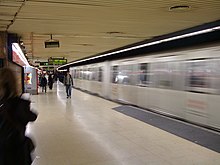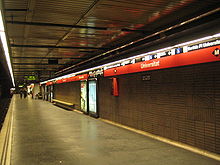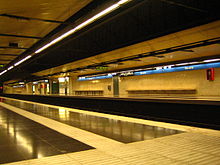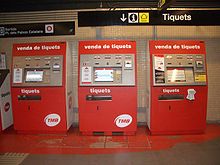This article needs additional citations for verification. (August 2021) |
| Barcelona Metro | |||
|---|---|---|---|
 | |||
 | |||
| Overview | |||
| Native name | Metro de Barcelona | ||
| Owner | TMB (Lines 1-5, 9-11), FGC (Lines 6-8, 12) | ||
| Area served | Barcelona metropolitan area | ||
| Locale | Barcelona, Catalonia, Spain | ||
| Transit type | Rapid transit | ||
| Number of lines | 12 lines (Total) | ||
| Number of stations | 189 (Total)
| ||
| Daily ridership | 645,000 [1] | ||
| Annual ridership | 355,560,000 (2018)[2] | ||
| Website |
| ||
| Operation | |||
| Began operation | 1863 (Partial) 1924 (Full) | ||
| Operator(s) | TMB (Lines 1-5, 9-11), FGC (Lines 6-8, 12) | ||
| Technical | |||
| System length | |||
| Track gauge | |||
| |||





The Barcelona Metro (Catalan and Spanish: Metro de Barcelona)[a] is a network of rapid transit electrified railway lines that run mostly underground in central Barcelona and into the city's suburbs. It is part of the larger public transport system of Barcelona, the capital of Catalonia, Spain, with unified fares under the Autoritat del Transport Metropolità (ATM) scheme. As of 2024, the network is operated by two separate companies: Transports Metropolitans de Barcelona (TMB) and Ferrocarrils de la Generalitat de Catalunya (FGC). It is made up of 12 lines, combining the lines owned by the two companies. Two lines, L9 and L10, are being built at present, with both lines having different sections of each opened between 2009 and 2018. They are due to be fully completed in 2030.[3] Three lines on the network have opened as automatic train operation/driverless vehicle systems since 2009: Line 11 being converted to driverless first, and then Lines 9 and 10, opening up driverless.
It is one of only two metros worldwide to operate on three different track gauges, being 1,000 mm (3 ft 3+3⁄8 in) metre gauge on line 8, 1,672 mm (5 ft 5+13⁄16 in) older Iberian gauge on line 1, and 1,435 mm (4 ft 8+1⁄2 in) standard gauge and the remaining lines; the other metro with three gauges being the Toei Subway in Tokyo, which uses two narrow gauges and standard gauge. It is the only metro worldwide to operate on both narrow and broad gauge tracks.
The network length is 170 kilometres (106 mi), with 183 stations, as of November 2021. It uses spare power from its regenerative braking to power charging stations in the vicinity of its infrastructure.[4]
- ^ "Discover how Barcelona organizes its Metro".
- ^ "Metropolitan Transport Authority – ATM" (PDF). ATM.cat. Retrieved 25 March 2020.
- ^ "El Govern retrasa hasta 2030 la entrada en servicio del tramo central de la L9 y la L10 del metro de Barcelona". 20minutos. Retrieved 20 August 2024.
- ^ Donback, Natalie (24 September 2024). "Barcelona is turning subway trains into power stations". Grist. Retrieved 24 September 2024.
Cite error: There are <ref group=lower-alpha> tags or {{efn}} templates on this page, but the references will not show without a {{reflist|group=lower-alpha}} template or {{notelist}} template (see the help page).
